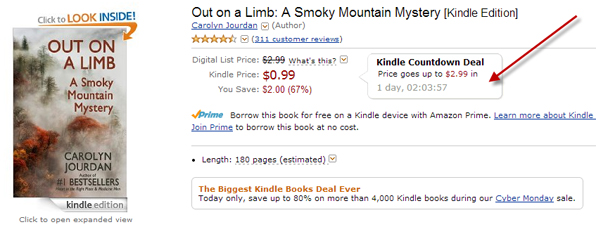The tremendous proliferation of ebooks has opened up opportunities for self-published as well as traditionally published authors. And as Amazon is the major online book retailer, at least in the U.S., you’ll want your ebooks on Amazon.
Here is the good news: Amazon makes this relatively easy to do.
Here is the bad news: It is not so easy to do this optimally.
Let’s start with terms:
Amazon is the overall site, although your ebook must be in Kindle’s ebook format (not compatible with other ebook formats such as on Barnes & Noble).
In theory you can upload your ebook from a Word document to the KDP (Kindle Direct Publishing) dashboard. For example, if you are in the U.S., you go to kdp.amazon.com to do this. You can use the same email and password you use for your regular Amazon account.
If you choose to allow Amazon to have an exclusive on your ebook (physical books are not part of this) for 90-day periods, you can sign up your ebook for KDP Select. This option makes your ebook free to borrow for Amazon Prime members (although you get paid for the borrow).
In addition, at this writing you now have two special KDP Select marketing options:
- You can have five days in any configuration in any 90-day period for your ebook to be free on Kindle.
- Or you can have your ebook take part in a Kindle Countdown Deal in the same period, subject to numerous conditions. A Countdown Deal allows publishers to run limited-time promotions on their books. Customers can see the regular price and the promotional price on the book’s detail page, as well as a countdown clock telling them how much time is left at the promotional price.
Note that you do not have to make this decision about KDP Select when you first upload a book. You can always go back and choose KDP Select at a later date.
When you upload your ebook, you must make an irrevocable decision about DRM. Here is Amazon’s explanation:
DRM (Digital Rights Management) is intended to inhibit unauthorized distribution of the Kindle file of your book. Some authors want to encourage readers to share their work, and choose not to have DRM applied to their book. If you choose DRM, customers will still be able to lend the book to another user for a short period, and can also purchase the book as a gift for another user from the Kindle store.
Important: Once you publish your book, you cannot change its DRM setting.
The discussion of whether to enable DRM on your ebook is beyond the scope of this blog post. You can do a search online to find information about this topic.
You also need to upload a cover – recommended width for Kindle cover is 1563 pixels and recommended height is 2500 pixels – or you can create a cover as part of the upload via the KDP dashboard.
Tip: Think about how small your cover appears on various Amazon pages and try to make the title at least clearly visible.
Speaking of titles, consider a subtitle to clarify what your book is about. For example, for my novel CIA FALL GUY, I have the subtitle A SPY THRILLER. Besides helping prospective readers of the story, this should also help assure Amazon search algorithms that the keywords I have attached to the ebook – such as spy and thriller – are accurate.
Now let’s return to the subject of formatting.
Yes, Amazon says you can upload a Word document – and there is a guide provided for formatting – but the formatting you may be able to accomplish in a Word document will probably not be optimal. This then often requires hiring someone who can code your ebook for Kindlegen (the Amazon proprietary conversion software that creates a well-formatted document if you have done all your coding correctly).
You are probably beginning to see how complicated the supposedly simple act of uploading an ebook via KDP can be.
But do not despair. KDP provides tons of detailed instructions once you are going through this process. Some info can be found on the right-hand side of the KDP screens once you start the process, other info can be found by clicking on the info prompts at various steps.
Of course, if you have not already previewed your Kindle ebook in a Kindle previewer after your ebook was coded and converted via Kindlegen before you started the upload process, you will want to preview it during the upload stage.
You may be surprised what you find if you have not carefully followed the guidelines. For example, a well-formatted Kindle ebook has a new chapter starting on a new screen. The ebook does not have a new chapter starting immediately after the previous chapter on the same screen.
If you choose, there are numerous options for hiring a company to format your Kindle ebook if you are a self-published author. You can ask for recommendations from your online contacts.
Two pieces of advice:
1. Make sure that the ebook is uploaded to your own KDP account and not the KDP account of the formatter. If you are not careful about this, you may discover that you have lost control of your own ebook, as I once did.
2. Make sure what you are hiring the formatter to do. If the formatter is hired to do the conversion, do NOT expect the formatter to find typos and spelling errors. All of these should have been discovered and found beforehand, presumably from hiring an expert proofreader/copy editor.
Then there is the question of deciding the price for your ebook, which affects the royalty amount you get for each ebook sold. The standard is 35 percent although you can choose 70 percent for ebooks priced between $2.99 and $9.99.
If you check ebooks in your genre on Amazon, you will see a wide range of prices. In fact, many self-published authors frequently change the price of their ebooks as part of their online marketing strategy.
In general I have found that the traditionally published ebooks, especially of popular authors, are priced higher than the ebooks of self-published authors. You can use other ebooks in your genre for a general comparison, but the ultimate price you decide on should be based on your own marketing strategy, including whether you are a brand-new author.
And remember, you can easily change the price of your Kindle ebook via your KDP dashboard (as long as the ebook is uploaded to your own KDP account), so the price is not written in stone.
You must then decide whether you want your ebook’s price in the different currencies on the Amazon country sites to be automatically set to the equivalent U.S. price (if you are uploading via the U.S. site) or to different prices that you set yourself.
Each of the above steps could take a whole ebook chapter of its own to explain, so please note that I am only covering the most important elements for each topic.
But here’s something that many new authors do not know:
Once your first ebook is live, go to authorcentral.amazon.com (if you are in the U.S.) and create an Author Central profile. This profile will then be connected on Amazon to your ebook. And each time you add a new ebook, you need to go back to Author Central to ensure that the new ebook has been added to your profile. (This is assuming the new ebook was written under the same author name as the previous ebook.)
One important word of warning: Because of quirks in the Amazon system at this time, only write your book’s description via the KDP upload dashboard and also only make changes to the description via the dashboard. Do not make description changes via your Amazon Author Central account.
Now when you want to share your Kindle ebook link on social media, copy the long URL at the top of the browser and go to bit.ly – this free site makes a shortened URL with an automatic Amazon notation in the shortened URL. (For example, see CIA FALL GUY at http://amzn.to/Sp29TC.)
One addition recommendation: Buy a copy of your own Kindle ebook from Amazon and double check how everything looks. Make sure there are no coding errors, such as strange symbols instead of apostrophes.
Final piece of advice: Keep up with what changes Amazon makes on its KDP dashboard. You will want to take advantage of any new opportunities.
* * *
 Phyllis Zimbler Miller is the co-founder of the digital marketing company Miller Mosaic, LLC and the author of fiction and nonfiction books/ebooks that can be found on Amazon. For extra help publishing your ebooks on Amazon, check out her ebook TOP TIPS FOR HOW TO PUBLISH AND MARKET YOUR BOOK IN THE AGE OF AMAZON. Contact Phyllis at pzmiller@millermosaicllc.com.
Phyllis Zimbler Miller is the co-founder of the digital marketing company Miller Mosaic, LLC and the author of fiction and nonfiction books/ebooks that can be found on Amazon. For extra help publishing your ebooks on Amazon, check out her ebook TOP TIPS FOR HOW TO PUBLISH AND MARKET YOUR BOOK IN THE AGE OF AMAZON. Contact Phyllis at pzmiller@millermosaicllc.com.







Phyllis–
As an author who’s gone through the pains of formatting and uploading a book on Kindle, I wish the process were less painful. I’m waiting for services and apps to show up to make it easier!
Susan, I’ve been wondering about this and I’m surprised somebody hasn’t come along with a solution to this problem. We don’t really need drones, do we? Just give us an easy way to format and upload ebooks.
Susan — I do know what a pain it is to correctly format and upload to Kindle
You can pay to have someone convert your book to the Kindle format, but, as I warned in the blog post. you have to be very careful about several things, including that the ebook is uploaded to your own KDP account.
Given how complicated the coding is for a well-formatted Kindlegen converted ebook, I’m not sure that there can be an easy program to do this. And no matter what, as authors we have to check the work of anyone doing the conversion for us to make sure that things are done correctly.
Hi. I published my novel as a paperback through CreateSpace first. At the end of that process they converted the file and loaded it into my KDP account along with the Kindle cover image.
Peter — Did you then look at your Kindle ebook? Do new chapters start on a new screen, for example?